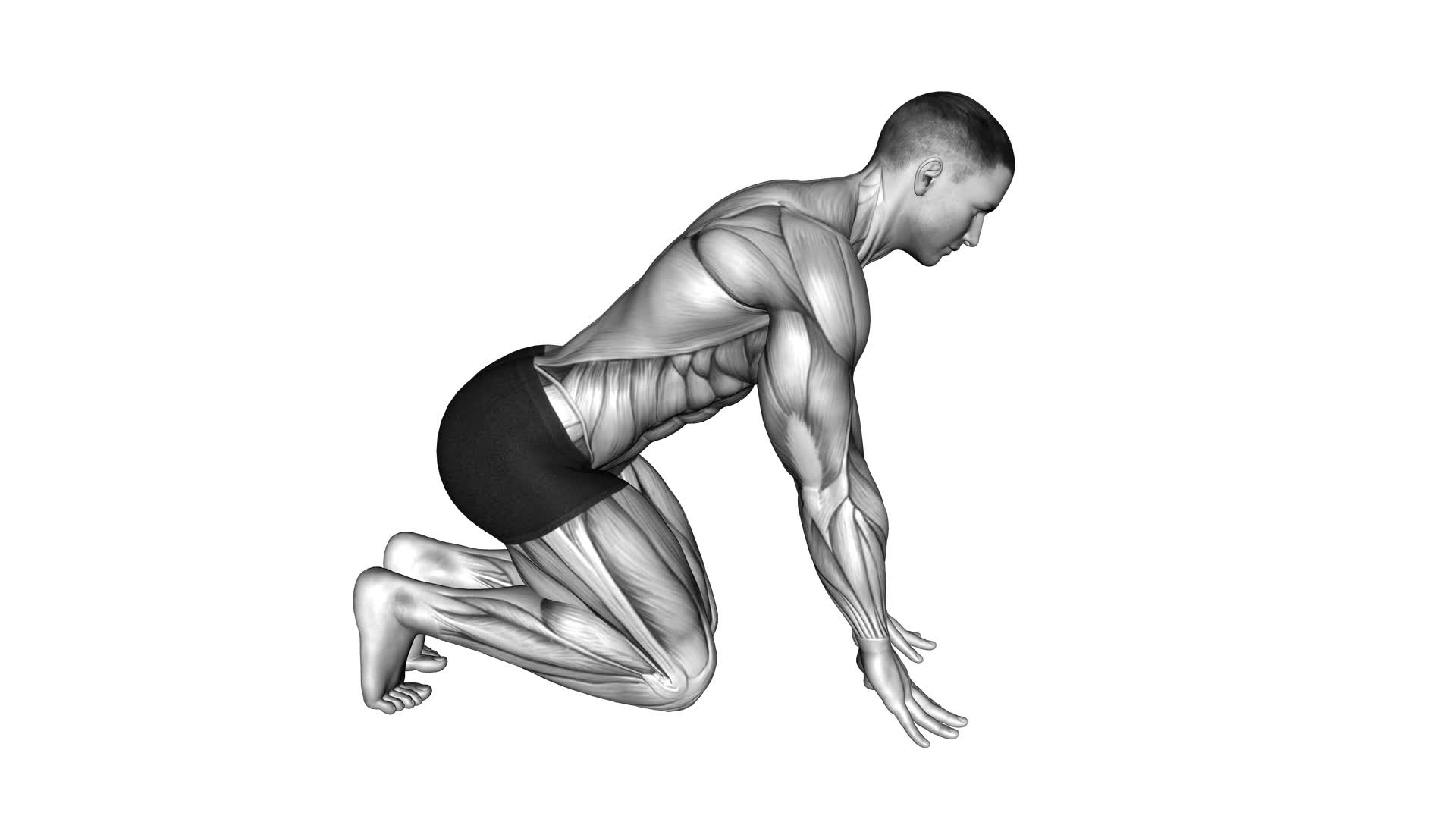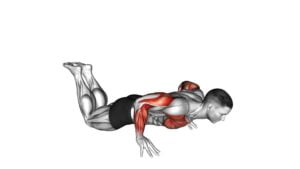Kneeling Finger Pulse (male) – Video Exercise Guide & Tips

Are you looking for a quick and effective way to strengthen your fingers? Look no further than the Kneeling Finger Pulse exercise.
Watch This Exercise Video
In this video exercise guide, we'll show you the proper form and technique for performing this exercise, along with variations and progressions to challenge yourself. Avoid common mistakes and maximize your results with these helpful tips.
Get ready to improve your finger strength and dexterity with the Kneeling Finger Pulse exercise. Let's get started!
Key Takeaways
- Kneeling Finger Pulse can improve circulation, deliver oxygen and nutrients, and remove toxins from the body.
- It can lower the risk of heart disease, high blood pressure, stroke, and alleviate symptoms in conditions like arthritis and diabetes.
- Proper form includes gently pressing fingers against the pulse point, maintaining a straight back and engaged core, and avoiding excessive weight on hands.
- Variations and progressions include adding resistance, increasing speed, performing on unstable surfaces, and progressing to more advanced modifications.
Benefits of Kneeling Finger Pulse
You will experience several benefits when practicing the kneeling finger pulse exercise. One of the main health benefits of this exercise is improved circulation. The movement of your fingers, combined with the pressure applied to your pulse points, helps to stimulate blood flow throughout your body. This increased circulation can have a positive impact on your overall health.
Improved circulation means that oxygen and nutrients are able to reach your organs and tissues more efficiently. This can improve the functioning of your organs and promote overall wellness. Additionally, better circulation can help to flush out toxins and waste products from your body, which can contribute to better overall health and a stronger immune system.
Regular practice of the kneeling finger pulse exercise can also help to reduce the risk of certain health conditions. Improved circulation can lower the risk of heart disease, high blood pressure, and stroke. It can also help to alleviate symptoms of conditions such as arthritis and diabetes.
Proper Form and Technique
To ensure proper form and technique for the kneeling finger pulse exercise, it's essential to maintain a comfortable and stable kneeling position throughout the exercise. Here are some key tips to help you perform the exercise correctly:
- Common misconceptions: One common misconception is that you need to apply excessive pressure during the finger pulse. However, the goal is to gently press your fingers against the pulse point without causing any discomfort or pain.
- Injury prevention techniques: It's crucial to keep your back straight and your core engaged throughout the exercise. This helps prevent any strain on your lower back. Additionally, avoid putting too much weight on your hands, as this can strain your wrists. Instead, distribute your weight evenly between your hands and knees.
- Proper hand placement: Position your fingers on the pulse point, which is usually located on the inside of your wrist, just below the base of your thumb. Make sure your fingers are relaxed and not tensed up.
- Breathing and relaxation: Remember to breathe naturally and stay relaxed during the exercise. Avoid holding your breath, as this can increase tension in your body.
Variations and Progressions
Explore different variations and progressions of the kneeling finger pulse exercise to challenge your body and enhance its benefits. Once you have mastered the basic form and technique, you can advance to more advanced modifications and techniques.
One advanced modification of the kneeling finger pulse is to add a resistance band. Attach one end of the band to a stable object and hold the other end with your fingers. As you perform the finger pulse, the resistance from the band will increase the intensity of the exercise and engage your muscles even more.
Another advanced technique is to increase the speed of your finger pulses. Instead of performing slow and controlled pulses, try to increase the tempo and pulse rapidly. This won't only challenge your muscles but also improve your coordination and agility.
If you want to further challenge yourself, you can also try performing the kneeling finger pulse on an unstable surface, such as a balance board or a Bosu ball. This will require you to engage your core muscles more and improve your overall balance and stability.
Remember to always listen to your body and progress at a pace that feels comfortable for you. As you continue to explore different variations and progressions of the kneeling finger pulse exercise, you'll experience new challenges and reap even greater rewards for your efforts.
Common Mistakes to Avoid
One common mistake to avoid when performing the kneeling finger pulse exercise is neglecting proper form and technique. To ensure you get the most out of this exercise and avoid injury, here are some common mistakes to avoid and misconceptions about the kneeling finger pulse:
- Rushing through the exercise: Many people tend to rush through the kneeling finger pulse exercise, sacrificing form for speed. It's important to take your time and perform each movement with control and precision to effectively target the muscles involved.
- Using excessive force: Applying too much force while performing the finger pulse can lead to unnecessary strain on your fingers and wrists. Remember to apply just enough pressure to feel the pulse and avoid any discomfort.
- Neglecting proper hand placement: Placing your hands too close together or too far apart can affect the effectiveness of the exercise. Make sure to position your hands shoulder-width apart and align your fingers with your chest for optimal results.
- Not engaging the core: The kneeling finger pulse exercise not only targets your fingers but also engages your core muscles for stability. Neglecting to activate your core can lead to poor posture and reduced effectiveness of the exercise.
Tips for Maximizing Results
Maximize your results by incorporating these tips into your kneeling finger pulse exercise routine. To maximize efficiency, make sure to maintain proper form throughout the exercise. Keep your back straight, engage your core, and avoid slouching or rounding your shoulders. This will help target the muscles effectively and prevent any unnecessary strain on your body.
Another tip for maximizing results is to incorporate resistance into your kneeling finger pulse exercise. You can do this by using a resistance band or adding weights to your wrists. The added resistance will challenge your muscles even more, leading to greater strength and endurance gains.
Additionally, it's important to gradually increase the intensity of your kneeling finger pulse exercise over time. Start with lighter resistance or shorter durations and gradually work your way up as your strength and stamina improve. This progressive overload will help you continue to make progress and avoid hitting a plateau.
Lastly, don't forget to listen to your body and give yourself enough time to rest and recover between workouts. Pushing yourself too hard without proper rest can lead to overtraining and potential injuries. Aim for at least one or two rest days per week to allow your muscles to repair and grow.
Frequently Asked Questions
How Long Should I Perform the Kneeling Finger Pulse Exercise?
To get the most out of the kneeling finger pulse exercise, it's important to know how long to perform it. The duration of this exercise depends on your fitness level and goals. Generally, it's recommended to perform the kneeling finger pulse exercise for about 10-15 minutes, three times a week.
This exercise helps improve blood circulation and finger strength. Make sure to follow proper form and consult a professional if you have any concerns.
Can Kneeling Finger Pulse Help Improve Cardiovascular Health?
Kneeling finger pulse is a beneficial exercise for seniors to improve cardiovascular health. It helps increase blood circulation and strengthen the heart.
Compared to other cardiovascular exercises, kneeling finger pulse is low impact and gentle on the joints, making it a suitable option for older individuals.
It can be performed for a duration of 10-15 minutes, three times a week, to achieve optimal results.
Incorporating this exercise into your routine can contribute to a healthier heart and overall well-being.
Is It Safe to Perform Kneeling Finger Pulse if I Have a Wrist Injury?
If you have a wrist injury, it's important to consider modifications for the kneeling finger pulse exercise. While kneeling finger pulse can be safe for most people, it may put strain on your wrists.
To prevent further injury, you can try alternative exercises that don't put pressure on your wrists, such as seated finger pulse or standing finger pulse. These modifications can still help improve cardiovascular health without aggravating your wrist injury.
How Often Should I Incorporate Kneeling Finger Pulse Into My Workout Routine?
To effectively incorporate kneeling finger pulse into your workout routine, it's important to consider the frequency. This exercise can be done daily or a few times a week, depending on your goals and fitness level.
Kneeling finger pulse offers numerous benefits for flexibility, as it stretches the muscles in your fingers, hands, and wrists. By regularly including this exercise in your routine, you can improve your range of motion and enhance overall hand dexterity.
Can Kneeling Finger Pulse Be Beneficial for Athletes in Specific Sports?
Kneeling finger pulse can be highly beneficial for athletes in specific sports. It helps improve finger strength, flexibility, and coordination, which are essential for activities such as climbing, grappling, and basketball.
Different variations of kneeling finger pulse exercises, like finger pulses with resistance bands or finger pulses on unstable surfaces, can also enhance grip strength and stability.
Incorporating this exercise into your routine can give you an edge in your sport by improving your finger dexterity and overall performance.
Conclusion
In conclusion, the kneeling finger pulse exercise is a beneficial workout for improving finger strength and flexibility.
By following proper form and technique, you can effectively engage the muscles in your fingers and hands.
Additionally, variations and progressions can be incorporated to challenge yourself and continue making progress.
Avoiding common mistakes and implementing the provided tips will help you maximize your results.
Incorporate this exercise into your routine for stronger and more agile fingers.

Author
Years ago, the spark of my life’s passion ignited in my mind the moment I stepped into the local gym for the first time. The inaugural bead of perspiration, the initial endeavor, the very first surge of endorphins, and a sense of pride that washed over me post-workout marked the beginning of my deep-seated interest in strength sports, fitness, and sports nutrition. This very curiosity blossomed rapidly into a profound fascination, propelling me to earn a Master’s degree in Physical Education from the Academy of Physical Education in Krakow, followed by a Sports Manager diploma from the Jagiellonian University. My journey of growth led me to gain more specialized qualifications, such as being a certified personal trainer with a focus on sports dietetics, a lifeguard, and an instructor for wellness and corrective gymnastics. Theoretical knowledge paired seamlessly with practical experience, reinforcing my belief that the transformation of individuals under my guidance was also a reflection of my personal growth. This belief holds true even today. Each day, I strive to push the boundaries and explore new realms. These realms gently elevate me to greater heights. The unique combination of passion for my field and the continuous quest for growth fuels my drive to break new ground.







